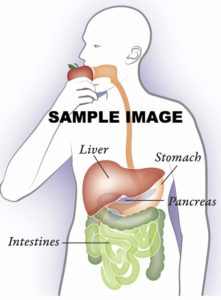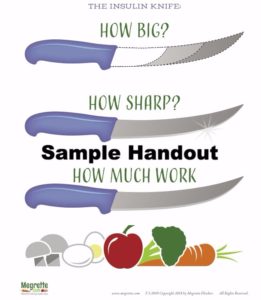 Many professionals that do not specialize in diabetes are unaware of how to communicate the complexity of type 2 diabetes. If you face that challenge and are looking for more ideas, consider purchasing Diabetes Counseling and Education Activities: Helping Clients without Harping on Weight. This book is a weight-neutral guide to explaining type 2 diabetes without harping on weight. The book covers 14 activities including:
Many professionals that do not specialize in diabetes are unaware of how to communicate the complexity of type 2 diabetes. If you face that challenge and are looking for more ideas, consider purchasing Diabetes Counseling and Education Activities: Helping Clients without Harping on Weight. This book is a weight-neutral guide to explaining type 2 diabetes without harping on weight. The book covers 14 activities including:
- Embracing a Weight Neutral Approach to Diabetes Care – This discussion is designed to help you understand why the Health at Every Size (HAES) movement is important for diabetes care. It continues to offer suggestions on how to avoid common counseling pitfalls and concludes with providing four points for bringing HAES into your MNT/DSMT program.
- The Insulin Knife: Part 1 – This handout and teaching activity explains the complexity of type 2 diabetes without the confusion. If you have been looking for a way to talk about insulin production, insulin resistance, and diet without weight loss, then the Insulin Knife is a perfect activity to learn. The activity breaks type 2 diabetes into three questions, each answer building on the next to provide a whole view of diabetes care.
 The Insulin Knife: Part 2 – A Deeper look into Insulin Resistance – This activity builds on the Insulin Knife handout. After presenting the Insulin Knife, many clients have questions and want to explore one of the three aspects of this concept in greater detail. The Insulin Knife: Part 2 focuses on the different factors contributing to insulin resistance allowing you to unpack this concept with confidence.
The Insulin Knife: Part 2 – A Deeper look into Insulin Resistance – This activity builds on the Insulin Knife handout. After presenting the Insulin Knife, many clients have questions and want to explore one of the three aspects of this concept in greater detail. The Insulin Knife: Part 2 focuses on the different factors contributing to insulin resistance allowing you to unpack this concept with confidence.- Thermostat: Understanding the Cause of Insulin Resistance – This handout and teaching activity explains the role of environment and lifestyle changes and how blood sugar levels shift as a result. Using a thermostat as an example, clients raise and lower their carbohydrate levels by changing the many variables contributing to or improving insulin resistance.
- Blood Sugar Rocket – This activity reviews the role of macronutrients and fiber in the diet. It explains in a simple way why some foods have little effect on blood sugar and others make them rise. The blood sugar rocket activity explains the concept in an interactive, kinesthetic way. Using this model, you can have clients change their rocket’s direction by shifting food choices or change the distance traveled by shifting the amount of food consumed. It is a fun, easy to understand analogy which helps clients establish a more balanced diet.
- How Much Work? A Deeper Dive into Diet – This activity explores the last concept in the Insulin Knife handout which is the question “How much work?” Breaking this question into four key concepts: distribution of calories, portions, carbohydrate load, and the glucose-blunting effects of a mixed meal, it helps clients easily understand lifestyle changes. In addition, this activity reinforces why restriction isn’t the answer for long-term diabetes care.
- Food Choices – This teaching activity will help clients who may be confused AND fearful of expanding their food and eating choices. Food exchanges and “those lists” have been a staple of diet culture, and when your client is a chronic-dieter casualty this fear comes from years of dieting (or trying to diet, but feeling like a failure). Chronic dieters, or partners of chronic dieters, need nonjudgmental, weight neutral education about food and nutrition choices focusing solely on how to nourish the body and not on weight or weight loss.
- Using Food Labels – Many clients have considerable confusion regarding how to read and interpret nutrition labels. There are many reasons for this confusion, the primary being the belief there is a diabetic diet in which they must choose specific foods (typically diet), or only have specific foods (typically diet, low fat, calorie modified). These beliefs come from society’s obsession with restrictive eating and the surrounding diet culture, which targets those with type 2 diabetes.
- Hypoglycemia, Hunger, and Fullness with Diabetes – This handout uses a hunger and fullness scale for diabetes care. This handout includes a counseling dialog for clients who are at risk of hypoglycemia due to medication or who may be experiencing hypoglycemic symptoms due to a poor diet.
- What About Weight? – Understanding the concept of weight neutrality is different than teaching it to clients. In this activity, you will explore how to help clients be more aware of moving from weight loss goals, and keeping their attention clearly focused on behaviors they believe are promoting health, blood sugar control, balance, and well-being.
- Inactivity and Exercise Resistance – Inactivity and exercise is a surprisingly complex topic to discuss with patients. This activity reviews three basic issues including: time management, the benefits of exercise, and self-doubt about the ability to exercise.
- Blood Sugar Experiments – Using the Meter – These counseling dialogs look at seven different situations which would benefit from blood glucose monitoring including: Getting a Meter, Elevated A1c, Not Testing, Blood Sugars All Over the Place, Blood Sugars Patterns, Experiments, Experiments 2 – Alcohol, Experiments 3 – Dinner and Experiments – Hunger/Fullness
- Liver Sponge – Explaining Hepatic Glucose Release – This teaching activity explains how to teach and counsel a client to understand the Dawn phenomenon, Somogyi Effect, Exercise and Alcohol, and the role of the liver in diabetes care.
- Emotional Eating and Disordered Eating in Type 2 Diabetes – Prior to developing type 2 diabetes, clients may have a history of disordered eating due to dieting or a previous diagnosis of an eating disorder. In this activity learn how to unpack emotional eating with diabetes in a compassionate, weight neutral way.
 Many professionals that do not specialize in diabetes are unaware of how to communicate the complexity of type 2 diabetes. If you face that challenge and are looking for more ideas, consider purchasing Diabetes Counseling and Education Activities: Helping Clients without Harping on Weight. This book is a weight-neutral guide to explaining type 2 diabetes without harping on weight. The book covers 14 activities including:
Many professionals that do not specialize in diabetes are unaware of how to communicate the complexity of type 2 diabetes. If you face that challenge and are looking for more ideas, consider purchasing Diabetes Counseling and Education Activities: Helping Clients without Harping on Weight. This book is a weight-neutral guide to explaining type 2 diabetes without harping on weight. The book covers 14 activities including: The Insulin Knife: Part 2 – A Deeper look into Insulin Resistance – This activity builds on the Insulin Knife handout. After presenting the Insulin Knife, many clients have questions and want to explore one of the three aspects of this concept in greater detail. The Insulin Knife: Part 2 focuses on the different factors contributing to insulin resistance allowing you to unpack this concept with confidence.
The Insulin Knife: Part 2 – A Deeper look into Insulin Resistance – This activity builds on the Insulin Knife handout. After presenting the Insulin Knife, many clients have questions and want to explore one of the three aspects of this concept in greater detail. The Insulin Knife: Part 2 focuses on the different factors contributing to insulin resistance allowing you to unpack this concept with confidence.